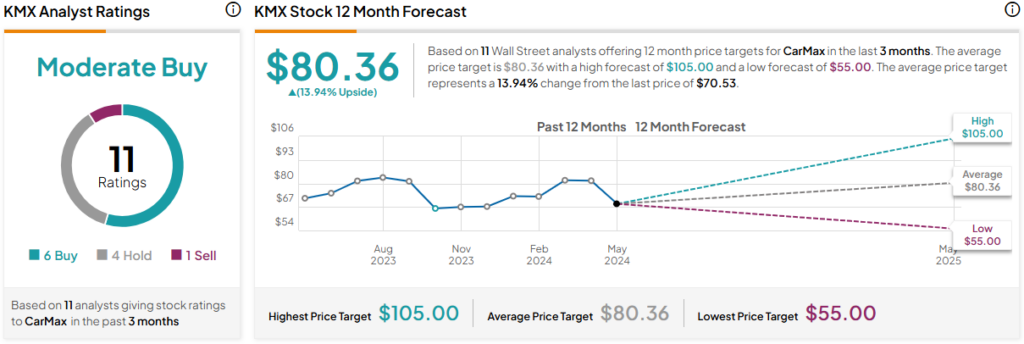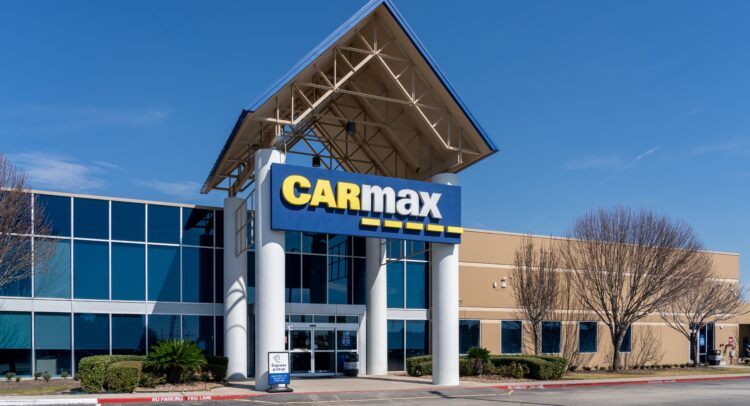Part of the reason why you shouldn’t depend heavily on the internet and social media to receive decision-influencing information is due to the inaccuracy of framing. Take used-car retailing giant CarMax (NYSE:KMX). Peruse your favorite video-sharing platform, and you’ll come across prognostications of doom and gloom for the enterprise and the industry.
Frankly, I think this bearish narrative is overkill. Yes, CarMax shares have slipped from their all-time highs and are also down from February 2020 levels. However, unless a secular downturn materializes, the evidence points to a reversion to the mean. Since CarMax stock is at a relative trough, it could potentially be discounted. Therefore, I am bullish on KMX stock.

No Need for Crisis-Level Concern for KMX Stock
I haven’t seen every video about CarMax, but the general theme appears to be that the company is too slow in responding to the market and dropping prices. Therefore, it is sitting on a ton of inventory that can’t be moved.
First, I believe it’s helpful to disabuse the notion that CarMax’s business planners represent a collective community of incompetent fools. These folks analyze market demand and consumer behaviors all the time. Indeed, by the scope of its retail network, CarMax is a massive sector-specific data goldmine. So, when a vehicle is priced at a certain level, it’s because the market data supports it.
Second, the rising inventory issue is almost certainly a model-specific dilemma. As of the latest read, inventory value stands at $3.68 billion. That’s well within the norm against recent quarters, if not lower.
Notably, in the quarter ended May 31, 2022, inventory value clocked in at $4.69 billion. Even accounting for the change in inflation, it’s difficult to classify KMX stock as suffering from excessive inventory. A solid indicator of demand for particular vehicle models is to consider the number of “likes” or heart-shaped icons on the CarMax website.
If you see a like count over 100, chances are very good that this car will be gone soon.
Fundamentally, one of the biggest factors to consider about KMX stock is that people need the underlying product. Yes, technically, CarMax falls under the consumer discretionary space. However, people need cars. And if return-to-office mandates start increasing, guess what? People won’t have the luxury of avoiding a vehicle purchase if their current rides fail.
Let’s also not forget that rising concerns exist about personal safety and U.S. public transit networks. This dynamic adds to the bullish case for KMX stock. In terms of numbers, the current fiscal year could see a slight dip. However, a revenue recovery is expected in Fiscal 2026 to $27.17 billion. If so, KMX stock – which presently trades at a modest trailing-year sales multiple of 0.42x – would be priced at 0.407x sales.
Inflation Trends Have Largely Normalized
Now, the big argument for supporting the bullish thesis of KMX stock centers on inflation. Basically, the framework of rising prices may not be as bad as you might think.
Back at the peak of inflation, the real M2 money stock expanded by 28.6% from February 2020 to December 2021. However, the Federal Reserve intervened with aggressive interest rate hikes. This cooled the temperature significantly, to the point where between February 2020 to April 2024, real M2 expanded by only 11.92%.
For arguably most Americans, that sounds like a lot. However, when you consider that the money stock increased by about a compounded annual growth rate (CAGR) of 4% during the 2010s decade, if you extrapolate the annual data from 2019 to 2024, we arrive at the following conclusion: based on natural economic trends and other dynamics, we would have reached the same level of M2 expansion had the pandemic never materialized.
Naturally, such a statement may arouse controversy. However, used-car prices – like most other product categories – are merely following the money stock’s trend. If you look at the consumer price index (CPI) for used cars and trucks, it’s true that prices have fallen since the February 2022 peak. However, prices are significantly elevated from pre-pandemic levels.
The difference between general inflation and car price inflation is that the former has been constantly rising. However, the latter had been fading from 2015 to mid-2020. Still, these dips generally correct back up eventually because again, people need personal transportation.
Another important point to consider about KMX stock is the wealth gap. Generally, most people across income categories saw their share of total net worth rise following the COVID-19 crisis. However, since the third quarter of 2022, those falling in the 50th to 90th wealth percentile are beginning to see wealth share erosion.
This circumstance suggests that there is a growing chasm between modestly skilled workers versus those who are either highly skilled or operate in desired industries. In other words, it’s clear that not everyone is experiencing the post-pandemic economy the same way. However, that’s an economic and social problem, not an issue necessarily tied to KMX stock.
Is CarMax Stock a Buy, According to Analysts?
Turning to Wall Street, KMX stock has a Moderate Buy consensus rating based on six Buys, four Holds, and one Sell rating. The average KMX stock price target is $80.36, implying 13.9% upside potential.

The Takeaway: Do Your Own Research Before Giving Up on KMX
At the end of the day, CarMax prices its vehicles based on what the market can bear. While it may generate clicks to say that KMX stock is about to implode because of silly business decisions, the evidence suggests otherwise. The company’s inventory levels are not aberrant. Further, with the Fed’s intervention, the amount of money circulating in the system is likely the same as it would have been if the pandemic never happened.
It’s true that used-car prices have fallen from their peaks. However, because of inflation and sector-related ebb and flow, prices are still elevated compared to pre-pandemic levels. The pain that some households feel when attempting to acquire a vehicle is much more reflective of wealth gap issues. That’s really an economic and social policy dilemma, which is outside the scope of KMX stock.
Questions or Comments about the article? Write to editor@tipranks.com
















